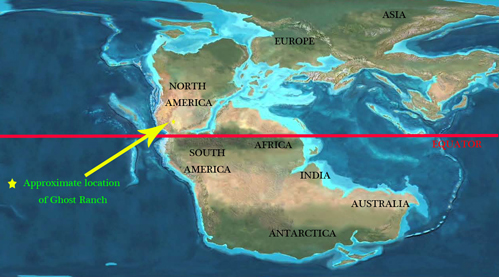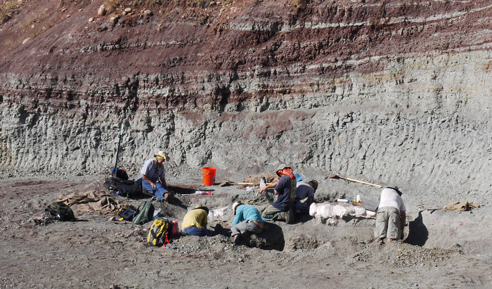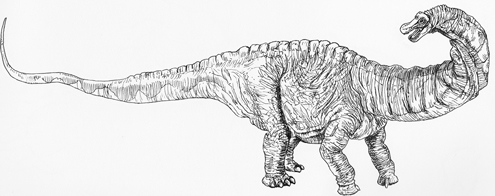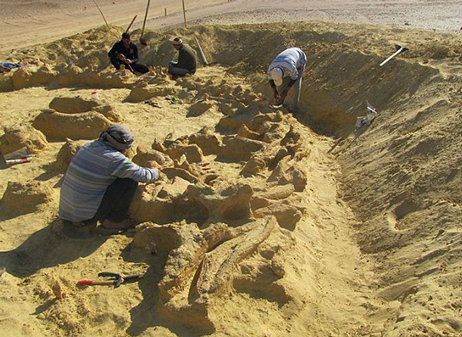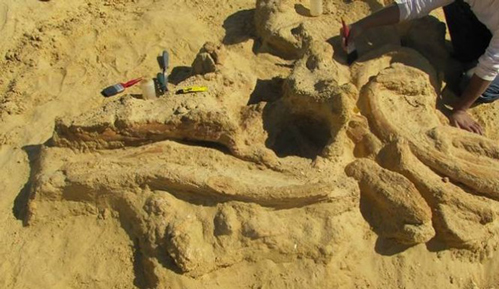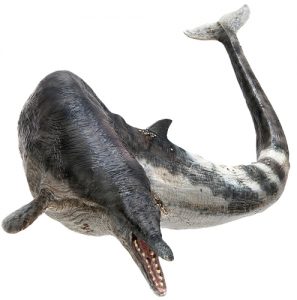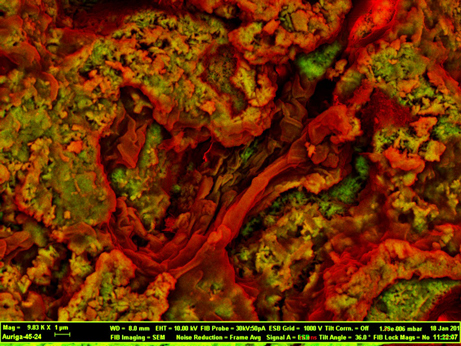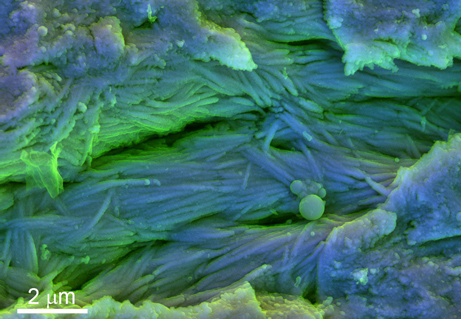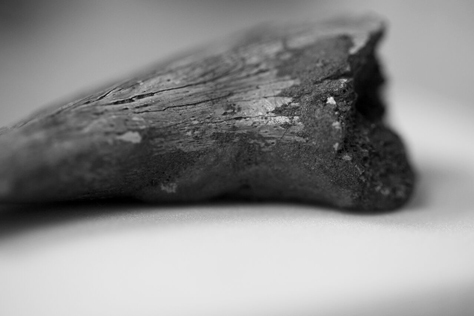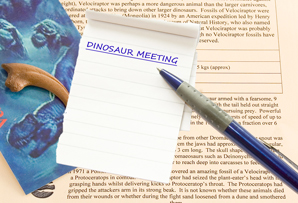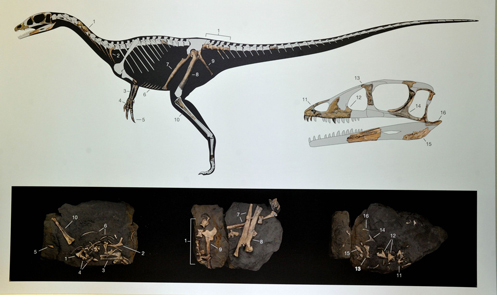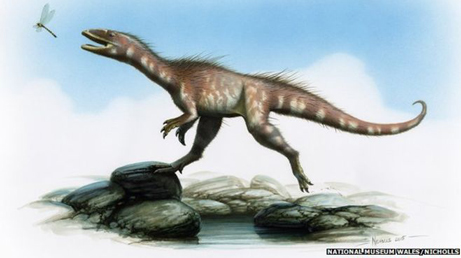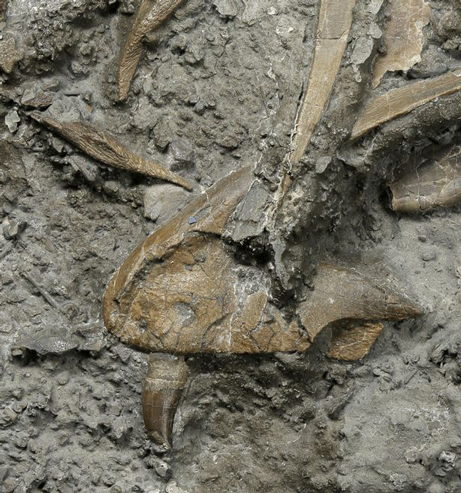Extreme Equatorial Climates Slowed the Rise of the Dinosaurs
Climate of the Tropics too Unstable for the Dinosaurs to Dominant in the Late Triassic
The vast majority of the reptile species found today are confined to the tropics. However, a new study undertaken by an international team of researchers suggests that during the Late Triassic as one group of reptiles came to dominate the land, the dinosaurs, they struggled to gain a foothold in the tropics due to extreme climate fluctuations.
Dramatic swings in the equatorial climate from wet and humid to extremely hot and dry checked the evolutionary development of the Dinosauria. Such conditions may be repeated in equatorial regions in the very near future due to increased amounts of carbon dioxide in the atmosphere as a result of global warming. What slowed the rise of the dinosaurs, could provide our species Homo sapiens with a viable model of what lies in store for us.
The Late Triassic of New Mexico
The Flora and Fauna of the Late Triassic (Ghost Ranch, New Mexico)
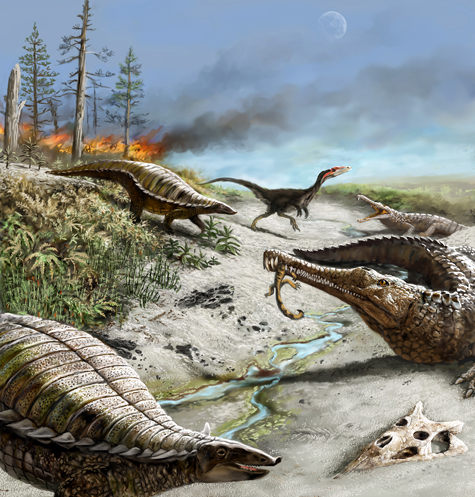
Dramatic climate changes from very wet to very dry conditions limited the range of large, herbivorous dinosaurs.
Picture credit: Victor Leshyk
The picture above shows a typical scene representing the flora and fauna of the Late Triassic (Ghost Ranch, New Mexico). Thick forests of primitive ,drought resistant conifers, araucaria, redwoods and podocarps dominate the landscape. Armoured aetosaurs (foreground and background) would have grazed upon ferns, club mosses and horsetails, whilst phytosaurs, which superficially resemble modern-day crocodiles, would have hunted small animals and mammal-like reptiles.
The vast majority of dinosaur fossils associated with the Ghost Ranch location (Chinle Formation), relate to small, theropod dinosaurs.
Late Triassic Equatorial Dinosaur Puzzle
What has troubled the curiosity of palaeontologists, is why so very little evidence of larger plant-eating dinosaurs have been found in rock formations that represent deposits laid down close to the Equator? The first dinosaurs might have evolved some 240 million years ago, perhaps slightly earlier. Although, the fossil record is far from complete, it is likely the first dinosaurs lived in the Southern Hemisphere.
Over the next thirty million years or so, the Dinosauria gradually diversified and spread. At this time in our planet’s history, most of the landmasses were joined together to form a single, super-sized land mass (Pangaea or Pangea). Fossils of sauropodomorphs have been found in Late Triassic strata from northerly as well as southerly latitudes but very few fossils of big, herbivorous dinosaurs have been found from locations that would have been close to the Equator.
The Ghost Ranch Fauna
Small-bodied, meat-eaters are found, although they do not make up a huge proportion of the total fauna, least not until the latter stages of the Triassic, but there is very little evidence to suggest the presence of large, plant-eating sauropodomorphs.
To read about the recent discovery of a new type of meat-eating, theropod dinosaur from the south-western United States: New Theropod Dinosaur Discovery Provides Evidence of Meat-Eating Dinosaur Diversification.
A Map of the World in the Late Triassic
Picture credit: North Arizona University with additional annotations by Everything Dinosaur
The map shows the approximate location of the Ghost Ranch site (New Mexico, USA), which during the Late Triassic lay close to the Equator.
The Rise of the Dinosaurs
To help understand the why certain types of dinosaur may have struggled to survive in the tropics, an international team of scientists, including researchers from the University of Southampton, have created a remarkably detailed picture of the ecology and climate of the famous Ghost Ranch fossil site (New Mexico).
The colourful rock layers preserved in this part of south-western United States represent a series of continental deposits, consisting mainly of sandstones and shales. They date mostly from the Late Triassic (Carnian and Norian faunal stages). The research team sampled different layers and used these samples to identify microscopic trace fossils such as plant pollen and fern spores.
Changing Plant Populations over Time
This provided the researchers with some understanding of the changing plant populations over time. This data was correlated with the work of organic geochemist Jessica Whiteside (Southampton University), who analysed carbon isotopes preserved in the rocks.
Dr Whiteside identified repeated highs and lows in the amount of “heavy” carbon-13 that was recorded, signs of major changes in the ecology of the area over time. These peaks and troughs lined up with changes in the composition of the fossil pollen and fern spores preserved This suggests that there were wild and dramatic climate swings leading to a flipping of floras, between a dominance of water loving species suited to a humid, warm and wet environment and those species that thrived when the climate became much more arid.
Dr Whiteside Taking Samples for Isotope Analysis

Researchers Jessica Whiteside and Maria Dunlavey taking rock samples for analysis of the isotopic signature of organic carbon at Ghost Ranch, New Mexico. These data help reconstruct ecosystem productivity and environmental changes in the Triassic.
Picture credit: Randall Irmis
Rapid Changing Environments
Commenting on the implications of this part of the study, Dr Whiteside stated that this see-sawing between wet and dry environments occurred as atmospheric carbon dioxide levels rose from around 1,200 part per million in the oldest rocks sampled up to 2,400 parts per million in the youngest rocks included in the study. These levels are well in excess of the current CO2 levels in our atmosphere (400 parts per million), but as global warming occurs and the amount of green house gases like carbon dioxide in the atmosphere increases, then we too, are likely to experience much more extremes in world weather.
Ian Glasspool, a specialist in studying ancient plant remains, examined the layers of charcoal that could be found in those sediments associated with the drier, hotter climate. These are the remains of trees that were caught up in forest fires that periodically swept through this part of the world in the Late Triassic. He measured the reflectiveness of the charcoal to estimate the intensity of the wildfires that had occurred.
Hot and Intense Forest Fires
The suggestion is that, the greater the amount of fuel available for a fire to consume, then the greater the heat generated. The biomass available to burn would be directly related to dry conditions, the drier the climate the greater likelihood of very hot forest fires due to the presence of so much combustible material.
The evidence from the charcoal samples support the idea of a tropical climate swinging violently from extremes. Severe droughts and forest fires would have continually reshaped the vegetation available for plant-eating dinosaurs. Perhaps the large bodied, sauropodomorphs, with their much greater food demands compared to other plant-eating reptiles, were not able to cope with the changes in the flora.
The Field Team Excavating Vertebrate Fossils
Picture credit: Randall Irmis
Note the clearly defined bands of different rocks which is a hall mark of the Chinle Formation. The layers represent different deposition environments, the red sandstones are coloured due to the amount of iron minerals that they contain. In the published academic paper that outlines this research, the scientists conclude that extreme climate fluctuation led to ecosystem instability in the tropics, which in turn suppressed the rise of the large, plant-eating dinosaurs in these regions.
Warm-blooded versus Cold-blooded
This new study may go some way to explain why fossils of small theropod dinosaurs are found amongst the vertebrate fossil assemblage, but the remains of large sauropodomorphs are extremely rare. Although this new research provides a fascinating insight into an prehistoric ecosystem, it throws up some intriguing but controversial ideas.
The scientists postulate that these extreme climates prevented large, active, warm-blooded herbivorous dinosaurs from becoming established in sub-tropical low latitudes until much later in the Mesozoic. It is suggested that the higher metabolic rates of plant-eating dinosaurs which were endothermic or had a form of endothermy (warm-bloodedness), prevented them from getting a foothold. They would have needed greater amounts of food to sustain them when compared to the other types of, presumably, cold-blooded reptile that did live in those regions.
The debate over dinosaur metabolism is not resolved and even if the majority of the Dinosauria were endothermic or even mesothermic (a combination of cold-blooded and warm-blooded features), the early long-necked dinosaurs and their descendants, the Sauropoda, may have been entirely ectothermic.
The Femur of a Small Meat-Eating Theropod Dinosaur Excavated by the Researchers
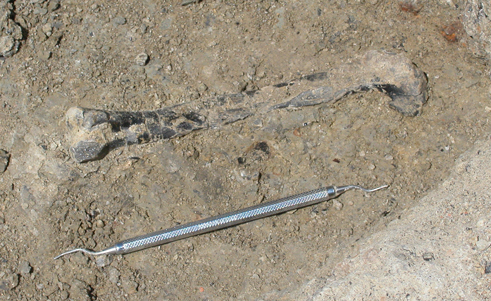
A fossilised dinosaur thigh bone (Ghost Ranch), only small dinosaurs were present close to the Equator.
Picture credit: Randall Irmis
The small scribe provides a simple scale. The distal end of the femur is towards the left of the photograph.
To read a short article about another early meat-eating dinosaur from the Ghost Ranch site: Buck Toothed Vicious Dinosaur Daemonosaurus chauliodus.


